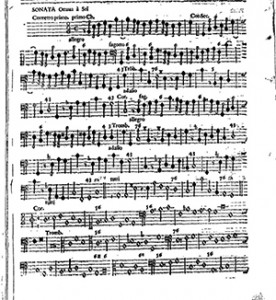Sonatas by Marini and Neri
 Magnificat’s program for the concerts on the weekend of December 19-21 will include instrumental sonatas by two of Francesco Cavalli’s colleagues at the San Marco: the organist Massimiliano Neri and the violin virtuoso Biagio Marini.
Magnificat’s program for the concerts on the weekend of December 19-21 will include instrumental sonatas by two of Francesco Cavalli’s colleagues at the San Marco: the organist Massimiliano Neri and the violin virtuoso Biagio Marini.
Born in the early 1620s, Neri was the son Giovanni Giacomo Neri, a Italian singer and theorbist who worked in several German courts. Massimiliano was appointed first organist at San Marco just before Christmas in 1644 and remained in the employ of the Basilica for two decades. Throughout his time in Venice, Neri maintained contacts with courts north of the Alps and visited Venice in 1651, where he was raised to nobility by Emperor Ferdinand III, to whom his second collection of ensemble sonatas was dedicated. Neri was appointed Kappellmeister to the Elector in Cologne in 1664.
The sonatas in Neri’s 1651 collection range from trio sonatas up to a sonata for 12 parts. With their varied instrumentation and rich contrapuntal writing the sonatas are remarkable as much for their debt to the polychoral tradition of an earlier Venetian generation as for their anticipation of harmonic organization crystalized by Corelli a generation later.
While his greatest impact on music of his time was no doubt as a virtuoso violinist, Biagio Marini also served as maestro di cappella in many courts on both side of the Alps. Born in Venice in 1594, he entered the employ of the Capella Marciana as a violinist just a few months before Cavalli’s arrival and was engaged there at least twice again, including the years just before the publication of his last collection of sonatas, op. 22, in 1655. After leaving Venice for the first time in 1620, Marini worked either as a violinist or maestro di cappella in Parma, Neuberg, Brussels, Milano, Bergamo and Düsseldorf.
Marini is credited with the many innovations in violin technique displayed in his many volumes of violin music, including double and triple stops and various scordatura tunings. He made many notable compositional experiements as well, for example a sonata “senza cadenze” or without cadences. In addition to his instrumental works Marini’s long and fruitful career also saw the publication of a significant body of sacred vocal music.